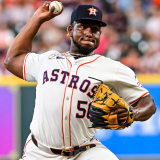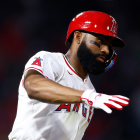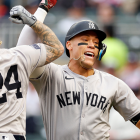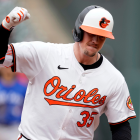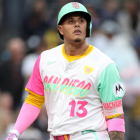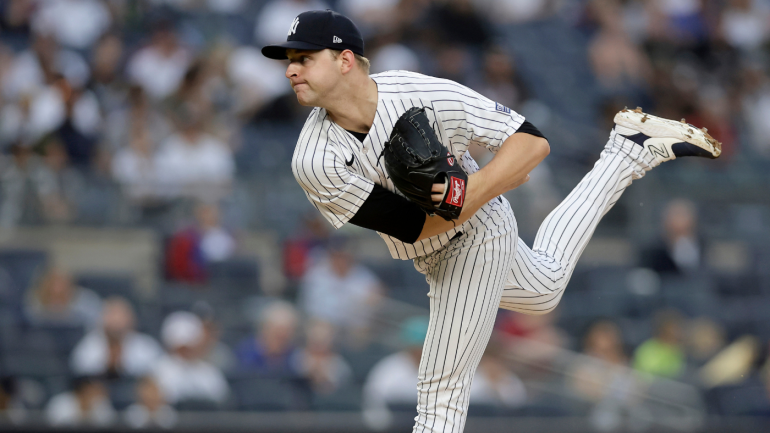
The New York Yankees are in the waning days of a disappointing season. Barring a miraculous run, these Yankees will result in all kinds of not-so-fun facts. To wit, this will be the first time they miss the playoffs since 2016; it'll be the fourth time they've missed the postseason since Brian Cashman became general manager in February 1998; and it could result in a last-place finish within the division, an outcome they haven't experienced since 1990.
Ignoring these Yankees at this point would be a perfectly reasonable, perhaps even healthy decision for most people. Yet that would mean missing out on an interesting recent development: Michael King's reintroduction to the rotation.
King, 28, has made five of his 16 career starts over the last month. He's compiled some impressive marks over those appearances, too, amassing a 1.27 ERA and a 7.25 strikeout-to-walk ratio in 21 innings. That's despite facing a few playoff-bound entities, like the Houston Astros and Milwaukee Brewers.
We here at CBS Sports are fond of a good reliever conversion story. As such, below we've offered up three aspects to King's transition worth monitoring.
1. Holding stuff deep into games
Arguably the biggest question facing any pitcher transferring from the bullpen to the rotation is how their stuff will hold up over longer outings. Don't take our word for it -- consider what manager Aaron Boone said recently. "[King] definitely has the weapons to do it. It's just a matter of transitioning, and can he then hold the stuff in extended outings?" he told the New York Daily News' Peter Sblendorio.
The idea of maintaining stuff into games can take a few forms. It can mean velocity, or it can mean maintaining the same quality of pitch -- with both playing a role in allowing a pitcher to turn over a lineup multiple times. Let's try to take a look at both elements from a quantifiable perspective.
Michael King's 7th and 8th Ks. pic.twitter.com/JdKsa9jbTS
— Rob Friedman (@PitchingNinja) September 14, 2023
To start, take a look at King's average sinker velocity by pitch count:
| Pitch count range | Sinker average velocity | 90th percentile |
|---|---|---|
1-10 | 94.4 mph | 96.1 mph |
11-20 | 94.5 mph | 96.1 mph |
21-30 | 94.2 mph | 95.8 mph |
31-40 | 94.3 mph | 95.9 mph |
41-50 | 94.8 mph | 95.8 mph |
51-60 | 94.3 mph | 95.3 mph |
61-70 | 94.2 mph | 95.3 mph |
71-80 | 94.4 mph | 96.1 mph |
81-90 | 94.6 mph | 95.4 mph |
That's about as consistent as you can get, huh? Now, here's how King's pitches have changed in usage and results as split by his role this season:
| Pitch type | Usage (SP-RP) | Whiff rate (SP-RP) | Chase rate (SP-RP) |
|---|---|---|---|
Fastball | 10.6% | -2.3% | -4.3% |
Sweeper | -8.6% | -4.4% | -5.2% |
Changeup | -1.9% | 10.2% | 7% |
To translate that table into words: King is throwing his fastballs (he has a sinker and a four-seamer) more frequently as a starting pitcher. He's had the chase and whiff rates on both his heaters and his sweeping slider decline, albeit in an expected manner. What's interesting is that King's changeup has roughly maintained the same usage rate while greatly improving its outputs.
Michael King's 2Ks in the 4th. pic.twitter.com/o0YlXQCppL
— Rob Friedman (@PitchingNinja) September 14, 2023
It used to be that the changeup was the make-or-break pitch for a starter. After all, that's the pitch most often leveraged against opposite-handed batters. Things aren't so simple anymore, what with teams shifting the goalposts on starter arsenals and workloads. Still, King's improved changeup performance may end up being a big positive for him if it sticks.
Based on the above information, we think King will continue to fare just fine in his starting endeavor from a stuff perspective. There are other aspects to consider that may end up proving more tricky for him, however.
2. Past injury issues complicate matters
The other big question that faces converted starters is the health component.
King, for his part, has already dealt with a smattering of injuries in recent years. You may recall that, just last summer, he had his season end prematurely after he fractured his elbow. Fortunately, he was spared Tommy John surgery that would've ruled him out for most or all of 2023. King also dealt with a stress reaction in his throwing elbow back in spring 2019.
King and the Yankees know better than anyone how his body is responding to his return to the rotation. We will note that during spring training he admitted his arm needed more time following multi-inning assignments versus single-frame outings, even when the pitch counts were equal.
Michael King, 95mph Paint. 🖌️🎨 pic.twitter.com/lzsFA7h2Fd
— Rob Friedman (@PitchingNinja) September 14, 2023
"It got to the point where it didn't really feel good at any day, but I would not tell trainers that and this is what happens," King told reporters in March. "But usually I'd say … I could throw a 40-pitch inning and actually feel good in a day or so, whereas if I spread out those 40 pitches over three ups [innings], the ups kind of get your heart rate down, back up, down, back up. And that, I think, takes a little bit more time."
The Yankees have wisely erred on the side of caution with his workload. He's ramped up his pitch count slowly, increasing from 50 tosses all the way up to 87. He's thrown more than eight additional pitches from one start to the next on just one occasion so far. It stands to reason that he'll be allowed to clear the 90-pitch threshold his next time out, Wednesday versus the Toronto Blue Jays.
For as careful as the Yankees have been with King's workload, it's worth establishing that no one can say for sure what the future holds for his arm. Even if he gets through this season unscathed, asking him to attempt a 25- or 30-start schedule next year might end up being too much of an ask. We'll see.
3. Worth a shot
Even with King's injury history, we think the Yankees are justified in giving him a look as a starting pitcher to wind down the season.
The state of New York's rotation is such that Gerrit Cole is the only pitcher you can feel confident in being a plus next season. Otherwise, the Yankees employ a series of question marks. Can Carlos Rodón bounce back from a dreadful first season in the Bronx? Will Nestor Cortes be healthier? Can Clarke Schmidt maintain success despite his vulnerability to lefty bats? And so on and so forth.
Of course, the Yankees aren't restricted from adding one or two external arms to the mix. The question is what exactly that will entail this winter. Cashman was recently in attendance for Japanese ace Yoshinobu Yamamoto's second career no-hitter. The Yankees are certain to face stiff competition if they pursue Yamamoto, including, perhaps, from their crosstown rival Mets.
The rest of the pitching free-agent class offers few sure things. Shohei Ohtani is unlikely to pitch at all next season. Blake Snell may win the National League Cy Young Award, but his well-below-average control makes him a wild card going forward. Lucas Giolito and Aaron Nola have both had uneven years. You get the point. The trade market could offer a few more enticing options -- perhaps a Corbin Burnes, a Brandon Woodruff, a Shane Bieber, or a Tyler Glasnow -- but, again, the Yankees will be one of many teams seeking help.
Identifying King as a potential solution, then, would take some pressure off their offseason. There's risk to the experiment, to be certain, and it's possible that his availability for the 2024 season becomes compromised. Still, pitching is an inherently risky activity, and one that rarely offers a sure thing. If it were any other way, stories like King's wouldn't intrigue us as much as they do.









